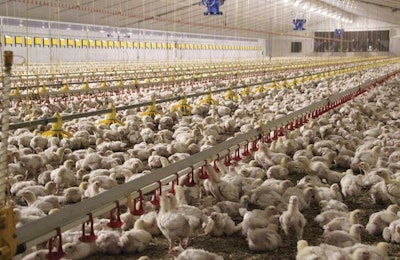
This article appears in the October issue of Poultry International. View all of the articles in the digital edition of this magazine.
While German poultry meat and egg production and consumption continue to rise, growth in both sectors has been weak since the start of the decade.
Total poultry meat production reached almost 1.80 million tons last year, up only slightly from 1.76 million tons in 2014, according to market data agency MEG. Where broiler meat was concerned, output grew marginally to 976,500 tons from 976,100 the year before.
While growth is predicted to continue, animal rights groups are strong in the country, and poultry production often criticized in the media.
“Nonetheless, consumers still do like poultry meat,” says Margit Beck, chief statistician with MEG. “With an increase of 300 grams, consumption per capita even reached 19.8 kg in 2015.”
Yet Beck expects that any further production growth in the coming years will be minimal.
“Growers voluntarily agreed on new animal welfare standards and switched to lower stocking densities of their flocks,” she says. “Only a limited number of new houses met with the new standards, as a result of which further production growth stagnated.”
Broiler market oversupply
Germany’s broiler producers are not only facing pressure from those calling for higher welfare standards, but also from competition from Brazilian, Thai and other European producers.
Additionally, the country was 111.5 percent self-sufficient in poultry meat last year, meaning that the sector must export if production is not to contract.
To a degree, German producers have a ready market for their export production via the German discount supermarket chains Aldi and Lidl, which are expanding substantially outside their home country. These retailers source on their home market and so absorb a fair amount of German poultry meat exports.
Despite these pressures on German broiler producers, however, there has been some relief.
The recent arrival of immigrants into the country, who have tended to be of North African and Middle Eastern origin, represent a new group of consumers that tend to favor consumption of poultry meat.

Germany poultry meat production and consumption have been gently trending upward since the start of the decade.
Low self-sufficiency for eggs
While Germany’s broiler meat producers produce more poultry meat than the country can consume, the opposite is the case where German egg production is concerned.
Despite the country being home to several large layer farms, German egg producers are unable to satisfy domestic demand, with the self-sufficiency rate being less than 70 percent for the past few years. Last year, the figure stood at 67.4 percent, with the country producing 792,000 tons of eggs, up slightly from 778 million tons in 2014.
The switch out of battery cages hit the German industry hard, with self sufficiency falling to as low as 50 percent.
German egg production is now rising and has reached levels last seen in 2008. But to satisfy domestic demand, Germany must export eggs.
Eggs are sourced from a variety of European countries, but primarily from the Netherlands and Poland.

While recovering, German egg production was heavily hit by the switch out of conventional cages.
After the switch out of conventional cages, German egg producers primarily adopted barn systems for the layers. Next in popularity were free-range and colony cages.
Organic production accounts for approximately 10 percent of the country’s layer flock, with the German public having a greater appetite for organic eggs than for organic chicken meat.

Barn production is now the main production method favored by Germany’s egg producers.
Find out more about the major poultry and egg producers in Germany:

















